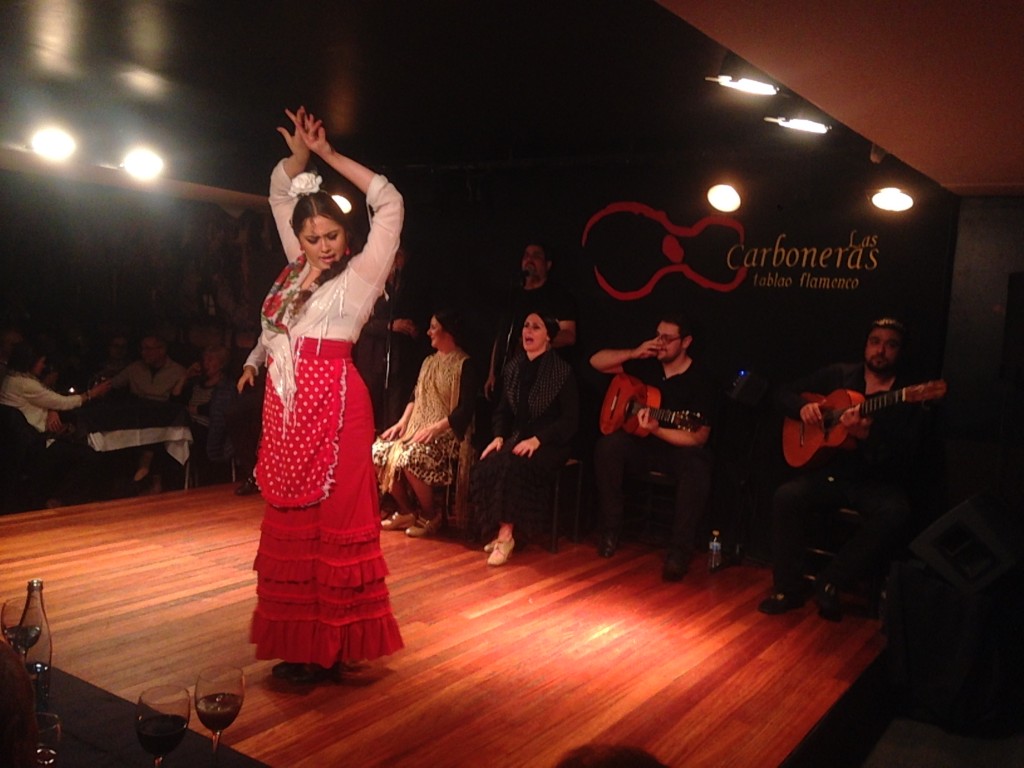It’s not a visit to Spain without the unparalleled experience of attending a flamenco show. I’m going to take you through my flamenco experience in a “how-to” format, so as to help you understand how to enjoy this gem of Spanish culture.
Step 1: Understand the history of flamenco
First, we need to learn about the flamenco before we experience it. Flamenco is a form of Spanish folk music and dance from the region of Andalusia in southern Spain. It includes cante (singing), toque (guitar playing), baile (dance) and jaleo, which are the vocalizations and rhythmic sounds of palmas (handclapping) and pitos (finger snapping) to accompany the dancer. The Romani people of Spain, also known as the Gitanos, or “gypsies” first practiced flamenco, and the music was first recorded in 1774. When the gypsies arrived to Andalusia from India, they brought with them their song and dance, and it didn’t become popular until the late 18th century.
Step 2: Find your flamenco show
There are many phenomenal flamenco bars and shows in Madrid, and most of the shows offer dinner while you watch the show. We went to Las Carboneras (www.tablaolascarboneras.com), which is located right near Plaza Mayor. Most of the time, it’s necessary to book your tickets in advance, and prices range from 40-80 euros. Book your tickets, and when the special night arrives, get dressed up and head to the show for dinner around 9:30 PM. The show will begin soon after.
 |
| Eating dinner at the flamenco bar before the show started. |
Step 3: Observe the guitarists and singers
In the band, you will usually find a couple of guitarists and a couple of singers, who also double as percussionists clapping their hands and snapping their fingers. At our show, two silky smooth guitarists with razor sharp jawlines were accompanied by two heavyset bearded men chanting incomprehensible Spanish noises. The guitarists’ fingers frantically improvised up and down the fret board, beckoning the singers passionate cries to increase in volume and passion as the night went on.
Step 4: Observe the dancers
There were four dancers who took turns, and when they were not dancing they were seated in front of the band. The women wore voluminous, elegant, frilly dresses and the men wore skin-tight trousers coupled with deep cut shirts to allow an overwhelming amount of chest hair to protrude ferociously. All of the dancing was unplanned and spontaneous – as each dancer felt the spirit of the flamenco overcome them, they stood up and went to town. The flamenco dancing touts an emotional intensity, proud carriage, and an expressive use of the arms and rhythmic stomping of the feet, or zapateado, which is used in conjunction with Palmas, or the intricate handclapping. The foot stomping combined with the rhythmic hand clapping was mesmerizingly deafening.
 |
| The passion is evident on the face of this flamenco dancer. |
Step 5: Breathe in the spirit of the flamenco
The perfectly poised explosion of passion, soul, emotion, and authenticity of flamenco is called duende. It is said that duende can only be experienced in mystical surroundings like an intimate flamenco session in which a singer will be possessed by the dark tones of the song and the spirit will enter the mind and soul of anyone who succumbs to it. The soul and passion of the dancers, singers and guitarists is evident on their faces as they lose themselves in their art.
Whether you believe in dark gypsy spirits or not, the emotion in the room during a flamenco performance is palpable. It is undeniable that you will leave a flamenco performance awestruck, with a greater understanding of Spanish culture, and with a new dance style to showcase to your friends.
Danny Pasternak is the Spring 2015 CEA MOJO Blogger in Madrid, Spain. He is currently a junior at the University of Michigan.







